On a cold, dark morning in early February 1959, a small plane carrying three rising music stars took off from an airfield in Iowa. It was just after 1:00 AM, and the weather was not good at all. What happened next would cast a very long shadow over the music world, making a moment that would be remembered as a time of great sorrow for many, many years to come. This event, so it's almost, shook people across the country, letting them know in a sudden, sharp way what was happening in the world then.
The names of those on board were Buddy Holly, J.P. "The Big Bopper" Richardson, and a young, incredibly promising talent named Ritchie Valens. Each one of them had a special way of connecting with listeners, and they were all on a music tour that had been quite a challenge, with long bus rides and cold conditions. The decision to fly that night, rather than endure another long bus trip, seemed like a good idea at the time, a way to get some rest and maybe catch up on laundry, but it led to a truly sad outcome.
This particular crash, you know, came to represent more than just a terrible accident. It became a symbol for the loss of youth, of potential, and of a certain kind of innocence in the early days of rock and roll. The story of Ritchie Valens, especially, is one that still moves people, a brief flash of brilliance that ended far too soon, leaving behind a body of work that, honestly, continues to capture hearts even today.
- Sophie Rain Spiderman Video Tutorial
- Colleen333 Nude
- Whitney Wren Nude
- Camilla Araujo Onlyfans Leaks
- Camillaaraujo Leaked
Table of Contents
- A Young Star's Quick Ascent
- Who Was Ritchie Valens?
- The Fateful Flight - What Happened During the Ritchie Valens Crash?
- The Weather's Role in the Ritchie Valens Crash
- A Tragic Aftermath - How Did the World React to the Ritchie Valens Crash?
- The Enduring Echo of the Ritchie Valens Crash
- Why Does the Ritchie Valens Crash Still Resonate?
- Beyond the Headlines - What Legacy Did the Ritchie Valens Crash Leave?
A Young Star's Quick Ascent
Richard Steven Valenzuela, who we all know as Ritchie Valens, came from a place called Pacoima, California. He grew up in a home where music was always around, with sounds from Mexico and America mixing together. From a very young age, he showed a real knack for playing music, picking up the guitar, trumpet, and drums with what seemed like very little effort. He just loved making sounds, you know, and spent hours practicing, trying out different chords and melodies. His natural gift for playing instruments was something many people noticed right away, and he would often play for family gatherings, showing off his growing skills.
By the time he was a teenager, Ritchie was already playing in a local band called The Silhouettes. He was a performer who really knew how to connect with a crowd, bringing a lot of energy to the stage. His performances were something to see, full of life and a real sense of fun. It was during one of these shows that a record company boss, Bob Keane, spotted him. Keane saw something special in Ritchie, a raw talent that just needed a little shaping. He quickly offered Ritchie a chance to make records, something that was, in fact, a huge step for a young person from Pacoima. This was the moment when his life, and his music career, began to move at a truly fast pace.
Ritchie's time making records was short, but he made a big mark. His first song, "Come On, Let's Go," got people tapping their feet, and then "Donna," a love song, became a huge hit. But it was "La Bamba," a song based on a traditional Mexican folk tune, that really showed his brilliance. He took an old song and made it new, giving it a rock and roll beat that no one had heard before. It was sung in Spanish, too, which was, quite frankly, a pretty big deal for the time. This song showed his roots and his vision for what rock and roll could be, mixing different sounds in a way that was very fresh and exciting for listeners.
Who Was Ritchie Valens?
To get a clearer picture of the young man who left such a big mark on music, here are some personal details about Ritchie Valens, a person whose time in the spotlight was brief but very bright.
| Detail | Information |
|---|---|
| Full Name | Richard Steven Valenzuela |
| Born | May 13, 1941 |
| Birthplace | Pacoima, California, USA |
| Died | February 3, 1959 |
| Age at Death | 17 |
| Occupation | Singer, Songwriter, Guitarist |
| Musical Style | Rock and Roll, Chicano Rock |
| Notable Songs | "La Bamba," "Donna," "Come On, Let's Go" |
| Years Active | 1958-1959 |
Ritchie was, in some respects, a trailblazer, opening doors for many who would come after him. His story, you know, is one of quick success and a talent that shone so brightly for a little while. He was just a kid, really, with a big dream and the skills to make it happen. His music had a sound that was all his own, a blend of what he heard around him and his own unique ideas. He showed the world that rock and roll could be more than just one thing, that it could have many different voices and sounds, which was, basically, a very important idea for music going forward.
The Fateful Flight - What Happened During the Ritchie Valens Crash?
The winter of 1959 saw Ritchie Valens, Buddy Holly, and The Big Bopper on a tour called "The Winter Dance Party." It was a tough schedule, with many stops across the Midwest. The musicians were traveling by bus, which, as a matter of fact, kept breaking down and had no heating. The conditions were really cold, and the performers were getting sick and tired. They were wearing out from the constant travel and the chilly nights on the road. The lack of proper rest and the biting cold were starting to take their toll on everyone involved in the tour.
After a show in Clear Lake, Iowa, Buddy Holly decided he had had enough of the bus. He made a plan to charter a small plane to take him, and his band members, to their next stop in Fargo, North Dakota, so they could get there faster and maybe get some sleep. The plane was a Beechcraft Bonanza, a small, single-engine aircraft. It was, in fact, meant to make things a little easier for them, to give them a break from the hard travel conditions. This decision seemed like a good one at the time, a way to avoid another long, uncomfortable ride on the bus, and get some much-needed rest.
However, there was a mix-up with who would fly. Buddy Holly's band members, Waylon Jennings and Tommy Allsup, gave up their seats. Jennings gave his seat to The Big Bopper, who was feeling unwell with the flu. Allsup and Ritchie Valens flipped a coin for the last seat, and Ritchie won. It was, just a little, a twist of fate that changed everything. The pilot, Roger Peterson, was young but had experience, though he was not familiar with flying in very bad weather conditions or flying with only instruments, which would become a very important point later on. The plane took off from Mason City Airport in Iowa, heading into the dark, cold night,


